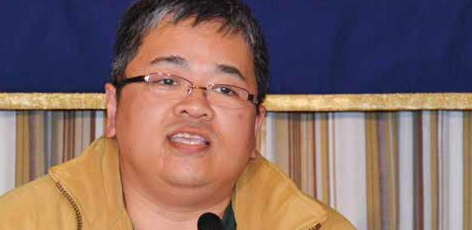Issue:

Two decades after a religious cult released sarin in the Tokyo subway, one of the victims is still searching for answers.
TWENTY YEARS IS A long time. But to documentary filmmaker Atsushi Sakahara, the morning commute he took on March 20, 1995, will stay with him forever.
“I remember getting in the third door from the front of the first carriage after the train pulled in at Roppongi Station,” Sakahara told a press conference at the FCCJ on the eve of the 20th anniversary. “I was holding a newspaper and I saw a free seat and I moved towards it, but I saw a folded newspaper on the floor leaking a clear liquid. I nearly stepped on it. I sensed concern in the other passengers and I turned around and went the other way down the carriage.”
Not sitting down probably saved Sakahara's life. “I remember very clearly that I was reading an article about the arrest the evening before of a senior member of the Aum Shinrikyo cult when my eyes began to feel strange,” he said. “I could not focus.”
Unable to shake his sense of unease, 48 year old Sakahara opened the connecting door to the next carriage and stepped through. A couple of people followed him, including a pregnant woman. “I heard someone behind me say a man in the other carriage had lost consciousness and I looked through the window at him,” he said. “As we came into Kamiyacho Station, some of the passengers carried him and another man off the train. I heard that one of them later died.”
As it has done every year since the attack, Japan marked the anniversary of the day on which domestic terrorists in the guise of a religious group launched a series of coordinated attacks that shook the nation’s sense of security.
Thirteen commuters and station workers died after members of the cult calmly pierced sachets of sarin gas with the sharpened tips of umbrellas. A further 6,000 people required hospital treatment for the effects of the gas, devised by the Nazis during World War II.
The attacks were, however, the final throes of an organization that had for more than two decades been convincing the young and the gullible that its leader, the half-blind former yoga instructor Shoko Asahara, was a reincarnated god.
It wasn’t their first criminal act. Asahara's followers had previously abducted and murdered a lawyer fighting the cult through the courts, along with his wife and their infant son. And they had plans for more: the cult had purchased assault rifles and a Russian helicopter and was allegedly attempting to obtain the components for a nuclear weapon, while its chemists began manufacturing sarin and VX gas in 1993.
Eight people died in an attack in June 1994 targeted at the judges hearing a case against Aum in the city of Matsumoto. When the cult realized in early 1995 that a raid on its headquarters was imminent, it went on the offensive. The subway sarin attack was reportedly designed to destabilize the government and cause sufficient chaos to enable Asahara to seize power.
Survivors reacted in different ways, says Sakahara. He resigned from his job at an advertising agency and moved to the U.S., where he completed an MA and produced a documentary, titled “Bean Cake,” that won a Palm d’Or at Cannes in 2001.
But he was unable to escape his past even after moving halfway across the world. He met a Japanese woman and planned marriage upon their return to Japan. Just days before the ceremony, she revealed that she had been a member of Aum Shinrikyo whilst at university. The marriage went ahead, but they were divorced within 18 months.
Today, he is close to completing a new documentary movie that focuses on Hiroshi Araki, the head of public relations for Aleph, a splinter group that emerged after the cult was aggressively targeted by the authorities but still swears allegiance to Asahara. Sakahara has been given rare access to the interior of one of the facilities still used by followers of Aleph.
A brief clip from the film, titled A Picture, showed members of the cult sitting on tatami mats and praying before an image of Asahara who is on death row along with 11 other members of Aum after being convicted of a raft of crimes. Sakahara says he is motivated by the desire to foster understanding of the victims of Aum’s attacks, who he believes have been marginalized and forgotten by a society that prefers not to think of the events of 20 years ago.
Equally, he believes followers of the cult that carried out the attack were victims. “Who listens to them,” he said, “carefully and without prejudice? How much do people really know about what happened?”
Members who cling to Aleph are “weak humans,” he added with a shrug. “They are in a kind of loop where they think or pretend that they are doing something good. That is why I embarked on this endeavor, this documentary.”
“People ask me if I am some sort of fan of Aum and my response is ‘of course not,’” he said. “My message is that I want to believe in fellow humans. Even if people kill each other in the name of religion, in the name of a country or a race, I still want to believe in the goodness of humans.”
Julian Ryall is the Japan correspondent for the Daily Telegraph.

